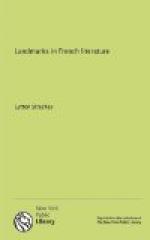With the generation of writers who rose to eminence after the death of Balzac, we come within the reach of living memory, so that a just estimate of their work is well-nigh impossible: it is so close to us that it is bound to be out of focus. And there is an additional difficulty in the extreme richness and variety of their accomplishment. They explored so many fields of literature, and produced so much of interest and importance, that a short account of their work can hardly fail to give a false impression of it. Only its leading characteristics and its most remarkable manifestations can be touched upon here.
The age was before all else an age of Criticism. A strong reaction set in against the looseness of construction and the extravagance of thought which had pervaded the work of the Romantics; and a new ideal was set up—an ideal which was to combine the width and diversity of the latter with the precision of form and the deliberate artistic purpose of the Classical age. The movement affected the whole of French literature, but its most important results were in the domain of Prose. Nowhere were the defects of the Romantics more obvious than in their treatment of history. With a very few exceptions they conceived of the past as a picturesque pageant—a thing of contrasts and costumes, an excuse for rhetorical descriptions, without inner significance or a real life of its own. One historian of genius they did indeed produce—MICHELET; and the contrast between his work and that of his successors, TAINE and RENAN, is typical of the new departure. The great history of Michelet, with its strange, convulsive style, its capricious and imaginative treatment of facts, and its undisguised bias, shows us the spectacle of the past in a series of lurid lightning-flashes—a spectacle at once intensely vivid and singularly contorted; it is the history of a poet rather than of a man of science. With Taine and Renan the personal element which forms the very foundation of Michelet’s work has been carefully suppressed. It is replaced by an elaborate examination of detail, a careful, sober, unprejudiced reconstruction of past conditions, an infinitely conscientious endeavour to tell the truth and nothing but the truth. Nor is their history merely the dead bones of analysis and research; it is informed with an untiring sympathy; and—in the case of Renan especially—a suave and lucid style adds the charm and amenity which art alone can give.
The same tendencies appear to a still more remarkable degree in Criticism. With SAINTE-BEUVE, in fact, one might almost say that criticism, as we know it, came into existence for the first time. Before him, all criticism had been one of two things: it had been either a merely personal expression of opinion, or else an attempt to establish universal literary canons and to judge of writers by the standards thus set up. Sainte-Beuve realized that such methods—the slap-dash pronouncements of




